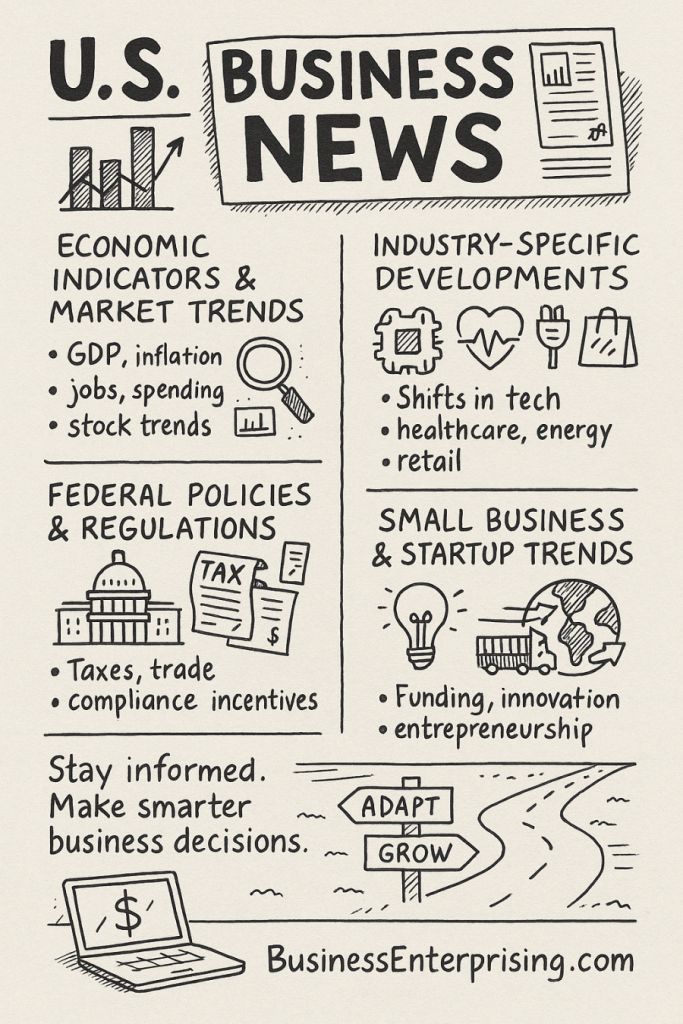
Economic reports, regulatory changes, and industry shifts all influence how businesses operate. Therefore, staying informed about these topics gives you an advantage in anticipating shifts before they affect your operations. Additionally, corporate earnings, mergers, and leadership changes often signal how competitors or partners may act. By paying attention to these updates, you can adjust your approach to better align with the market environment.
Small business trends, startup activity, and foreign investment also play significant roles. Therefore, you should view these developments as signals of where opportunities may arise next. Additionally, trade policies and supply chain issues continue to influence costs and availability, making them important factors in planning. When you combine awareness of both local and global developments, your strategies become more effective and resilient.
By making U.S. business news part of your regular routine, you position yourself to make smarter, more confident decisions. Therefore, treating information as a resource helps you protect your business while also preparing for growth. Additionally, the insights you gain from consistent updates allow you to identify opportunities, strengthen operations, and stay ahead of change.
Economic Indicators and Market Trends
Economic indicators provide a snapshot of how the economy is performing and where potential challenges may arise for businesses. GDP growth is often the first measure you watch because it reflects overall economic health. When growth slows, demand often follows, affecting your revenue outlook. Therefore, you need to stay aware of quarterly reports and their impact on consumer confidence.
Inflation also plays a major role in your operations. Rising prices increase costs for raw materials, transportation, and labor. Additionally, inflation affects your customers’ purchasing power, which can reduce demand for your products. Therefore, monitoring inflation trends helps you plan pricing and manage expenses effectively. However, periods of low inflation can create opportunities for investment and expansion.
Employment data provides another important measure of economic strength. High employment usually supports consumer spending, while rising unemployment signals weakening demand. Therefore, you should track labor reports to anticipate changes in hiring needs and wage pressures. Additionally, employment trends often signal shifts in productivity and industry growth.
Consumer spending is closely tied to these factors. When confidence is strong, people spend more, which supports business growth. However, reduced spending often leads to lower sales, especially in retail and service sectors. Therefore, analyzing spending reports gives you insight into customer behavior and market demand.
Stock market performance rounds out the picture. While it does not always reflect daily business activity, it influences investment, retirement accounts, and consumer sentiment. Additionally, a strong market often supports funding opportunities and expansion plans. Keeping track of these trends helps you prepare for shifts and adapt your strategy effectively.
U.S. business news often highlights these indicators because they shape both short-term performance and long-term planning for companies like yours.
Federal Policies and Regulations
Federal policies and regulations shape the environment where you run your business, often influencing taxes, trade, and compliance requirements. When government introduces new tax laws, your planning, pricing, and investment strategies may all shift. Therefore, staying current on changes allows you to adjust before they impact your bottom line. Additionally, updated rules can provide incentives that reduce your costs or open new opportunities.
Trade agreements also affect how you source materials and sell products abroad. When tariffs rise or agreements change, your supply chain and pricing can be disrupted. Therefore, reviewing new agreements helps you anticipate challenges and explore alternate suppliers or markets. Additionally, favorable trade policies can create fresh export opportunities for your business. However, the complexity of these agreements often requires careful review before making decisions.
Regulatory changes influence compliance, safety, and reporting standards. Industries such as healthcare, finance, and energy often experience frequent updates. Therefore, you must remain attentive to new rules that impact daily operations. Additionally, adopting compliance measures early helps you avoid penalties and reputational risk. By treating regulation as an ongoing part of planning, you create resilience against unexpected shifts.
Federal policies also shape long-term industry growth through programs, subsidies, or restrictions. Therefore, you should evaluate how new initiatives align with your goals and adjust accordingly. Additionally, you may find new opportunities when government funding supports technology, sustainability, or workforce development.
U.S. business news regularly covers these policy changes because they directly affect companies like yours. By keeping informed, you can make proactive decisions, strengthen your compliance, and position your business for stability and growth.
Industry-Specific Developments
Industry-specific developments often highlight the sectors driving the economy forward and those facing fresh challenges. Technology continues to lead with innovations in artificial intelligence, cloud computing, and automation. These changes affect how you manage operations, reach customers, and compete in crowded markets. Therefore, keeping track of emerging tools and digital platforms helps you adapt and maintain relevance.
Healthcare also remains a sector with constant shifts. New treatments, expanded telehealth, and medical technology are creating opportunities for growth. Additionally, policy changes and consumer demand for accessible care are shaping how providers deliver services. Therefore, if you operate in or serve this industry, watching these updates can guide your strategy.
Manufacturing is evolving through advanced robotics and smart supply chain systems. Companies are finding ways to reduce costs while boosting efficiency. Additionally, trends in reshoring and automation may impact your sourcing and production choices. Therefore, tracking manufacturing developments can help you anticipate changes in both pricing and supply availability.
Energy remains central to business planning as renewable power, efficiency standards, and sustainability initiatives expand. Therefore, you may see new opportunities to reduce operating costs and meet consumer expectations for cleaner practices. Additionally, traditional energy markets continue to shift, affecting pricing and investment opportunities across industries.
Retail also shows ongoing transformation with e-commerce growth, direct-to-consumer models, and new customer experiences. Therefore, you should evaluate how digital tools, logistics, and customer expectations influence your sales strategy. Additionally, changes in consumer behavior often spread into other industries, making retail trends worth following.
U.S. business news consistently highlights these industry developments because they influence decisions across every sector. By paying attention, you can align your strategies and position your business for growth.
Corporate News and Earnings Reports
Corporate news and earnings reports provide insight into how major companies perform and where markets may be heading. Quarterly reports reveal sales trends, profits, and growth areas, offering you a way to measure industry momentum. Therefore, reviewing these results helps you understand competitive pressures and potential opportunities in your own sector. Additionally, consistent performance from industry leaders often boosts market confidence.
Mergers and acquisitions also shape business activity. When two companies combine resources, they may expand their market share or reduce competition. Therefore, you should monitor these developments, as they can influence pricing, supply chains, and customer expectations. Additionally, acquisitions often bring innovation by blending talent, technology, or distribution networks. However, integration challenges can sometimes slow expected results.
Leadership changes create another source of market impact. A new executive team may introduce strategies that alter company direction. Therefore, paying attention to these shifts helps you anticipate how industry practices may evolve. Additionally, leadership transitions often influence investor sentiment, which can affect stock prices and public confidence.
Corporate strategies like cost-cutting, expansion into new markets, or investment in technology often appear in public reports. Therefore, you can learn from these moves and consider how they may affect your competitive environment. Additionally, strategies from industry leaders sometimes set broader trends that filter down into smaller businesses.
U.S. business news frequently covers these developments because they influence decisions across industries. By following earnings, mergers, leadership, and strategies, you gain insight into where markets may shift. Additionally, this awareness gives you perspective that supports smarter planning and better long-term positioning.
Small Business and Startup Trends
Small business and startup activity continues to shape the economy, often setting trends that larger companies later adopt. New funding opportunities, from crowdfunding platforms to angel investors, are giving entrepreneurs more ways to access capital. Therefore, you can explore different paths to secure resources that align with your goals and growth plans. Additionally, the rise of online platforms makes funding more accessible to a broader range of founders.
Entrepreneurial activity remains strong as more people seek independence and innovation. Many startups are entering sectors such as technology, healthcare, and sustainability, where new ideas often gain quick traction. Therefore, you should pay attention to these industries for insights into future demand. Additionally, regional hubs are expanding beyond traditional centers, creating more options for where you can start or grow a business.
Innovation is also driving the startup ecosystem forward. Advances in digital tools, artificial intelligence, and cloud-based services are lowering barriers to entry. Therefore, you can scale operations faster and reach customers more efficiently. Additionally, these tools allow smaller companies to compete with larger players in ways that were once limited. However, rapid growth still requires careful planning and solid execution.
Small businesses also adapt quickly to changing consumer preferences. Trends in e-commerce, local services, and direct-to-consumer models often begin with smaller enterprises. Therefore, watching these movements can help you anticipate changes in your own market. Additionally, these shifts highlight the importance of flexibility and responsiveness in long-term success.
U.S. business news frequently highlights startups and small businesses because their growth influences innovation, employment, and investment patterns. By staying informed, you gain perspective on where opportunities may arise and how to position your business effectively.
Global Influences on U.S. Business
Global influences have a direct effect on how your business operates and grows within the U.S. market. International trade dynamics often shape supply availability, pricing, and competition. Therefore, shifts in tariffs, agreements, or global demand can alter your costs and sales opportunities. Additionally, trade disputes or partnerships often change the flow of goods, requiring you to adjust sourcing strategies.
Supply chain issues have also become a central focus for many businesses. Delays in shipping or shortages of materials affect operations across industries. Therefore, you need to track global logistics developments to anticipate risks and adapt your planning. Additionally, diversifying suppliers or investing in domestic sourcing can reduce vulnerabilities created by global disruptions. However, such adjustments often require balancing higher costs against improved reliability.
Foreign investment trends also impact U.S. businesses. When international investors direct funds into U.S. companies, new capital and partnerships can drive growth. Therefore, you may find opportunities to expand or collaborate with firms supported by global interest. Additionally, rising foreign investment often signals confidence in specific sectors, offering you valuable insights into potential growth markets.
Currency fluctuations and global economic health further influence domestic markets. Therefore, changes in exchange rates can affect import prices, export demand, and profit margins. Additionally, economic slowdowns in major markets can ripple into reduced demand for U.S. products and services. Staying informed about these shifts helps you adjust strategy before they affect your bottom line.
U.S. business news consistently highlights these global influences because they affect companies of every size. By monitoring trade, supply chains, and investment flows, you position yourself to respond effectively and protect your future growth.
Conclusion
Staying informed about economic indicators, policy changes, industry trends, and global influences helps you make smarter decisions for your business. Each development carries potential risks and opportunities that affect how you operate. Therefore, reviewing updates regularly gives you the context needed to plan with confidence. Additionally, understanding patterns across different sectors allows you to adapt more effectively.
Corporate earnings and mergers reveal shifts in competition and growth, while small business activity highlights emerging innovations. Therefore, following these updates can give you ideas for improving your own strategies. Additionally, paying attention to funding opportunities and investor activity may help you identify new sources of capital. By learning from these developments, you can strengthen your position in a fast-moving environment.
Global trade and supply chain issues continue to influence pricing and access to resources. Therefore, building awareness of international factors helps you anticipate challenges before they disrupt your operations. Additionally, monitoring foreign investment trends can point you toward industries gaining momentum. These insights provide you with an edge as you prepare for future growth.
U.S. business news offers a window into these complex but important dynamics. By keeping up with reports, you gain clarity on how policies, markets, and industries shift. Therefore, you can make proactive choices that protect your business and expand your opportunities. Additionally, a consistent focus on these updates keeps you prepared for both immediate needs and long-term goals. By treating information as part of your strategy, you create a stronger foundation for growth. Therefore, stay engaged, study the trends, and use the knowledge to guide your decisions with purpose.



